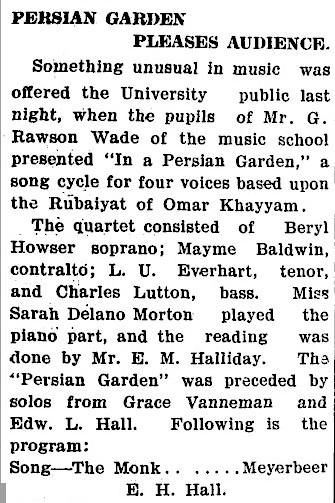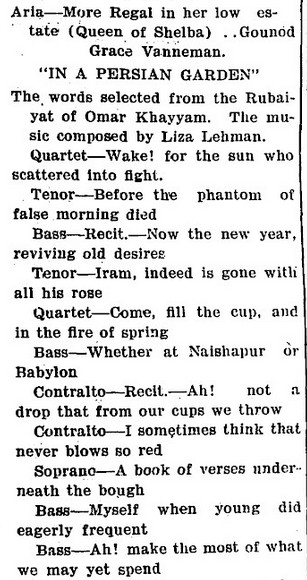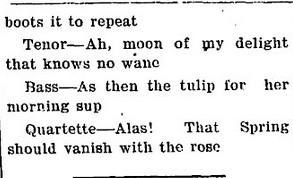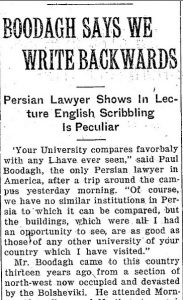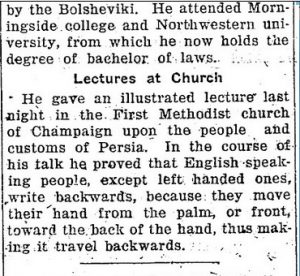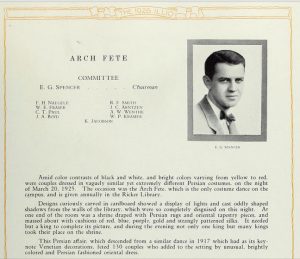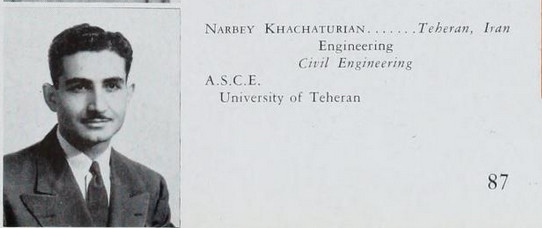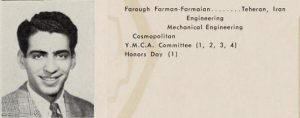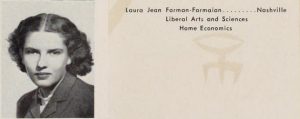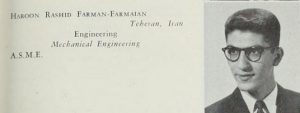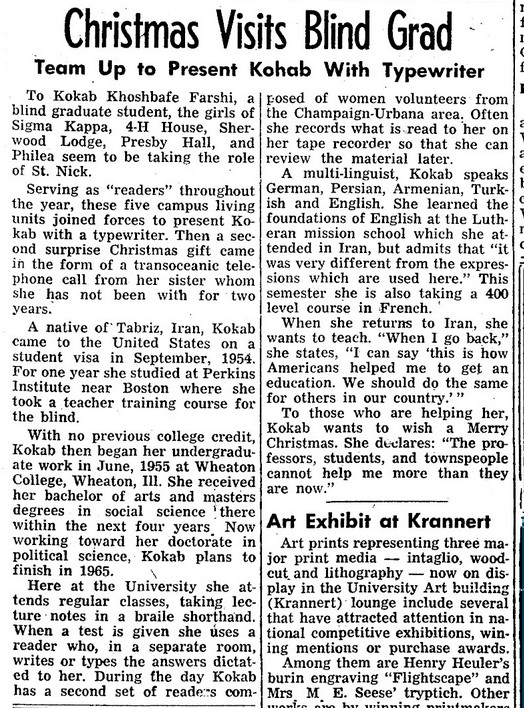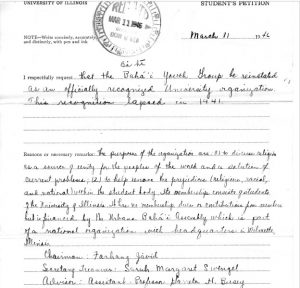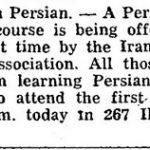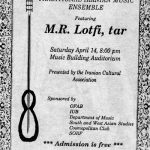Since at least 1907, Iranian students have been attending the University of Illinois. Some early Iranian Illini have included architectural engineers, architects, chemical engineers, civil engineers, computer scientists, economists, electrical engineers, food technologists, linguists, materials scientists, mechanical engineers, medical doctors, political scientists and transfer students, to name a few. Read on to learn more about early Iranian Illini!
The first Iranian Illini may be an unidentified student in 1907. [1] Almost no record of the unknown student has been identified yet; however, there were other students soon after.
Just eight years later, Mr. Aram M. Aleazarian, of Tehran, (B.S. Electrical Engineering, 1915) completed an engineering degree and a thesis on wireless telegraphy and telephony. Previously, Mr. Aleazarian was a student at the University of Wisconsin at Madison, where he was a founding member of the Armenian Students of Wisconsin student organization. [2] While at Illinois, Mr. Aleazarian was a member of the multi-cultural student groups Cosmopolitan Club, Le Cercle Francais, and L’Alliance Francaise, as well as an occasional speaker on Persian education and society too. Then, another eight years later, the next Iranian Illini was Mr. Allah Khan who was also the nephew of the Iranian Ambassador to the United States in 1919. Although Mr. Khan may not have graduated, he left behind at least one interview with the Daily Illini.
Concurrent with the arrival of the first Iranian students, some University community members were already embracing Persian arts and culture–while the University library began building a Persian collection too. English translations of Persian language poetry (like Edward Fitzgerald’s translation of Omar Khayyam‘s poems) were performed and read. In fact, some translations were set to music and performed on campus too between 1900 and 1910. [3] Then, in 1915, the Broadway production of Richard Walton Tulley’s “Omar the Tentmaker” came to the Illinois Theater and the production was even positively reviewed by the Daily Illini. [4]
During the 1910s, off campus, religious speakers came to Champaign-Urbana to speak about cultures and religions in Iran. For example, the Bahá’í community was growing in cities like Chicago, New York, Champaign, and Urbana. [5] Bahá’í speakers like Janabi Fazel came to town to speak at least twice to the local community too. Local religious communities, like the Unitarian church, even hosted talks about Bahá’í faith and Bahá’í poetry by writers like Kurratu’l-Ayn. Also, Iranian Christians, like lawyer and Reverend Paul Mirza Boodagh, visited the community to speak about cultures and religions in Iran too. In a 1921 talk, Mr. Boodagh humorously convinced his audience that writing a Latin-based script, like English, with the right hand, was physically backwards and unnatural when compared to writing in other scripts.
Meanwhile, University community interest in Iran continued to grow. In 1921, Economics Professor Ernest Ludlow Bogart took a one-year leave-of-absence to work as a financial advisor to the Persian government. Upon his return, Dr. Bogart gave multiple campus talks about the state of Iranian economy. More about Professor Bogart can be read in the Ernest L. Bogart Papers, (Record Series 9/5/21).
Student interest in Iranian cultures continued through the 1920s. For example, for every spring, the student Architecture club “Arch Club” organized an annual costume party known as the “Arch Fete” at the Ricker Library. Often, the themes were set in locations like Greece or Venice. However, in 1925, the Arch Fete coincided with the spring solstice holiday “Nowruz”(celebrated by many cultures including the many cultures of Iran, as well as Kurdish cultures too) and the 1925 Arch Fete theme was set in Iran. While a photo and narrative of the 1916 event, which included decorations and costumes inspired by Venice, Baghdad, and Samarkand can be found in Illinois Magazine, Volume 8, Number 1, October 1916; unfortunately, only a description of the 1925 party has been located.
Following the establishment of the new Iranian government in 1925, Iranian Illini enrollment increased for the next fifty years.
In 1939, Mr. Hussein Sadik may have been the first of many future Iranian civil engineers at Illinois.
Mr. Narbey Khachaturian of Tehran, (B.S. Civil Engineering, 1947, M.S. 1948, PhD 1952) was an award-winning researcher and professor of structural analysis, optimization, and structural design in civil engineering at the University. [6] Upon his acceptance to the University, Mr. Khachaturian left Tehran five weeks before his twenty-first birthday in 1944. His voyage to the United States took 129 days, after a series of delays and complications resulting from sea travel impacted by fighting during World War Two. After completing his bachelors degree, Mr. Khachaturian completed his Masters and PhD at Illinois too, before joining the faculty in 1952. Beyond his research and instruction duties, Dr. Khachaturian held multiple administrative positions including Assistant Dean of Engineering and Associate Head of the Department of Civil Engineering. Today, in memory of Dr. Khachaturian, Nathan M. Newmark Civil Engineering Laboratory includes the Narbey Khachaturian Lecture Hall.
Throughout the 1950s and 1970s, many Iranian students continued to come to the University to study. While some of those students’ stories are not available in an archives yet, a few Iranian Illinis’ biographies have been written, like Nejde Hagobian and Andre Minassian in David N. Yaghoubian’s Ethnic Identity and the Development of Nationalism in Iran in 2014.
Other students, like Mr. Bijan Mohraz, (B.S. Civil Engineering, 1961, PhD, 1966) completed all of his degrees at Illinois before becoming a professor and researcher of earthquake engineering, structural dynamics, structural analysis and design at Southern Methodist University. [8]
While many students studied engineering, some studied other fields like architecture, business, mathematics, and political science. In fact, the last two fields were studied by some of the first Iranian women Illini. As seen below, Ms. Shirin Shaisy might be the first Iranian woman to complete a Bachelors degree in Mathematics at the University.
Meanwhile, the University continued to further develop research and development connections with Iran too. [10] During the 1960s, Professor Charles E. Osgood (Communications and Psychology, 1949-84) and Professor Joseph McVicker Hunt (Psychology, 1951-1974 and Elementary Education, 1967-1974) collaborated to organize a research field office in Tehran. Over time, in collaboration with the University of Tehran, the Tehran Illinois Research Unit was established in Tehran and the Illinois Tehran Research Unit was established in Urbana-Champaign. The Unit was closed at the time of the Iranian Revolution of 1978. More information can be found in the Tehran Research Unit File, 1965-76 (Record Series 24/2/15) and Tehran Research Unit Campus Coordinator’s File, 1968-77 (Record Series 24/2/16).
Just over one hundred years after the earliest Iranian Illini was on campus, as recently as December 11-13, 2008, the University hosted the “Conference on Iran’s Economy”. The conference planners acknowledged the University’s historic connections with Iran while organizing, supporting, and networking both local and international economic scholars to promote further study of Iran in the future. [11]
Student Organizations
Before the first Iranian student organizations, Bahá’í students organized the Bahá’í Youth Group (1946-1976). While some of the original members were from Iran, today, Bahá’í student organizations have included members from many different national backgrounds.
Since at least 1961, Iranian students have formed at least 5 student organizations at the University of Illinois at Urbana-Champaign. While some groups have lasted for solely one year, other groups have organized for many years. First, there was the Iranian Student Association (1961-1978) which was a resource group for students from Iran. Today, the Iranian Cultural Association promotes the awareness and exploration of Persian or Iranian arts and cultures, including organizing poetry and play readings, inviting guest speakers and performers, as well as an annual Nowruz spring solstice celebration every March. [12]
In fact, at least as early as 1964, Iranian Illini voluntarily arranged to tutor any interested students in learning Farsi. In 1988, the Iranian Illini arranged for an Iranian folk ensemble performance which included Mohammed Reza Lotfi to perform on the tar.
For over one hundred and ten years, Iranian students have been coming to the University of Illinois at Urbana-Champaign. Iranian Illini have come from a variety of cultural backgrounds and they have found equally various success in their respective careers. Some stories have expanded to included multiple generations of Illini in a single family. Indeed today’s campus includes many graduate students too and the welcomed possibility of this second century of Iranian Illini to continue strong too.
Are you an Iranian Illini? Do you know someone who is? We’d like to hear from you! Please send us a message or leave a comment below. We want to include you and your story, as we celebrate the first 150 years of the University of Illinois.
Happy First 150 everyone!
(A special thank you to Middle East & North African Studies Librarian Laila Hussein Moustafa who provided feedback on an early version of this idea.)
References
[1] “Foreign Students at Illinois,” May 27, 1908, The Daily Illini, page 5. In 1905, Mr. Elisha Elijah Sayad, of Urmia, graduated from the College of Medicine in Chicago; however, the the DI article must be referencing someone even earlier.
[2] As Mr. Eleazarian explains in the following essay, although an independent Armenia exists today, historically, Armenian cultures have lived across the region which includes modern-day Turkey, Russia, and Iran. Please see: “The Armenian Students at Wisconsin“, by Aram M. Eleazarian, Wisconsin Alumni Magazine, May 1912, Volume 13, Number 8, 364-365.
[3] Not missing an opportunity to joke about the University and student life, one student even wrote a three-part series of creative essays in the style of a “Persian prince” to complain about everyday life. Please see: “El-Gym, or the House of Madness“, “Persian Letters: II“, “Persian Letters: III” by L. Goldmerstein. Please note that some of the student’s choice of language or humor does not imply University of Illinois community values.
[4] Mr. Tully’s production may be based on an older story of the same name by Nathan Haskell Doe.
[5] More information about Iranian cultures, including the followers of the Bahai faith, can be found in the online Encyclopaedia Iranica as well as Bahaikipedia.
[6] His son and grandson were Illini too. For a detailed biography, please see: “Narbey Khachaturian“, News Gazette, May 14, 2009; “Professor Khachaturian Passing“, CEE at Illinois, May 15, 2009.
[7] “Farough Farman-Farmaian“, Washington Post, March 21, 2014.
[8] “Department of Civil and Environmental Engineering Bijan Mohraz“, Southern Methodist University Lyle School of Engineering, accessed March 20, 2017.
[9] More information may be available in the biographical files of the Wheaton College Archives and University of Illinois at Urbana-Champaign University Archives. Ask an archivist for more information.
[10] For a detailed history, please see: “About the Tehran Research Unit“, by Fouri Minoo-Archer, Conference on Iran’s Economy, accessed March 20, 2017.
[11] “Conference on Iran’s Economy“, University of Illinois at Urbana-Champaign, December 11-13, 2008.
[12] Some groups include: Iranian Student Association, (1961-78); Iranian Moslem Student Association, (1984); Iranian Earthquake Relief Committee; and the Iranian Cultural Association (1988- ). Be sure to check out early Iranian student publications too in “Student Organizations Publications, 1871-” (Record Series 41/6/840).

